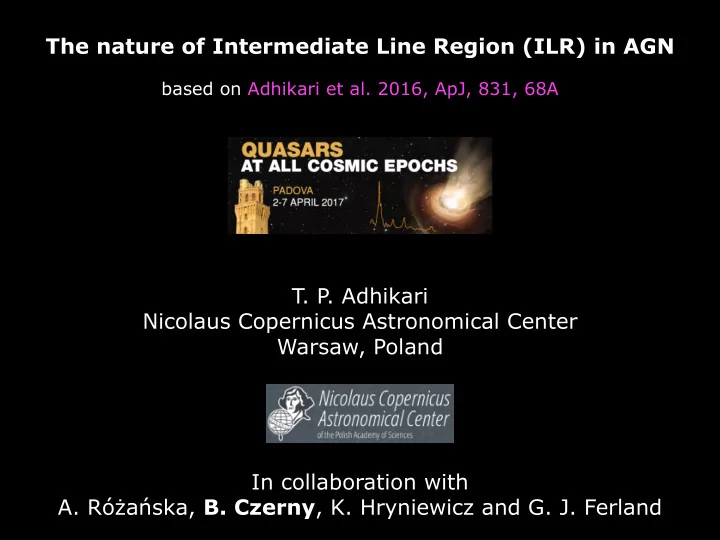

The nature of Intermediate Line Region (ILR) in AGN based on Adhikari et al. 2016, ApJ, 831, 68A T. P. Adhikari Nicolaus Copernicus Astronomical Center Warsaw, Poland In collaboration with A. Ró ż a ń ska, B. Czerny , K. Hryniewicz and G. J. Ferland
Urry & Padovani 1995
Emission lines in the spectra of AGN narrow lines: FWHM~500 km /s broad lines: FWHM>2500 km /s Mehdipour + 2015
"Line emission vs radius" in AGN Netzer & Laor 1993 model • constant density gas clouds • n H ∝ R − 3/2 , N H ∝ R − 1 • n H , N H at 0.1 pc = 10 9.4 cm -3 & 10 23.4 cm -2 • Solar composition <=0.1 pc • ISM composition with dust grains >0.1 pc
Recent observations (Brotherton+1994, Puchnarewicz & Jones 1996, Crenshaw & Kraemer 2007, Hu+ 2008a,b, Crenshaw+ 2009, Zhu+ 2009, Li+ 2015) of some AGN shows intermediate line emission STIS echelle observation of NGC 5548 Intermediate lines: FWHM ~690 km /s Crenshaw+ 2009 continuum + BLR (lower dotted–dashed green), continuum + BLR+ NLR (upper dotted–dashed green), continuum + BLR + ILR (dashed red) and continuum + BLR + ILR + NLR (upper dashed blue)
H 𝛾 decomposed into H 𝛾 VBC and H 𝛾 IC (Hu + 2008) 568 quasars Z<0.88 H 𝛾 VBC ( 5730±58 km/s) H 𝛾 IC (1428±18 km/s) The lack of correlation between the EWs of H 𝛾 VBC and H 𝛾 IC strongly suggests that the two components are emitted from different regions.
"Line emission vs radius" in AGN Netzer & Laor 1993 model • constant density gas clouds Intermediate lines: FWHM ~ 700-1600 km /s ? • n H ∝ R − 3/2 , N H ∝ R − 1 • n H , N H at 0.1 pc = 10 9.4 cm -3 & 10 23.4 cm -2 • Solar composition <=0.1 pc • ISM composition with dust grains >0.1 pc
Photoionisation modelling of the emitting gas • Gas density n H • Broad band SED incident SED • Metallicity Z • Column Density N H • Ionisation parameter U • Radiative transfer, ionisation equilibrium and thermal balance emission lines • Main Codes: CLOUDY, TITAN, XSTAR,.. Cloudy 13.03 (Ferland + 2013)
Is the presence of ILR in some AGN connected with the shape of SED? Adhikari + 2016, ApJ
The answer is no! Adhikari + 2016, ApJ
Our model assumptions 3 9 9 1 r o a • constant density clouds L & r e • n H , N H at 0.1 pc = 10 9.4 z t e • n H ∝ R − 3/2 , N H ∝ R − 1 cm -3 & 10 23.4 cm -2 N • N H at 0.1 pc = 10 23.4 cm -2 • Solar composition <=0.1 pc • ISM composition with • n H at 0.1 pc = 10 11.5 cm -3 dust grains >=0.1 pc High local densities (~ 10 11 -10 12 cm -3 ) of emitting and absorbing clouds in AGN have been inferred for several sources (Leighly 2004, Bruh- weiler & Verner 2008, Rozanska+ 2014, Hryniewicz + 2014, Modzelewska+ 2014, Sredzinska + 2016)
Dense clouds: potentially formed from an accretion disk atmosphere disk vertical structure calculations (Pojmanski + 1996, Rozanska +1999) BLR emission clouds may be connected with the wind from an accretion disk atmosphere (Gaskell 2009, Czerny & Hryniewicz 2011)
No suppression in line emission ! ILR at distances 0.1-1 pc Adhikari + 2016, ApJ
High density clouds have lower H + column gas opacity always dominates for higher densities and it does not matter if the gas is dusty or not Adhikari + 2016, ApJ
H 𝛾 peak: 0.1<r<0.4 pc He II peak: r<0.1 pc Mg II peak: r<0.1 pc O [III] peak: r~60 pc consistent with the results inferred from Reverberation Mapping (RM) studies (Bentz + 2009, Koshida+2014) Adhikari + 2016, ApJ
Two important predictions of our model • Existence of ILR at distances 0.1-1 pc predicts the RM lag of ILR to be 100-1000 light-days • In our case, the effect of dust disappears if U is less than 0.01 (threshold value). So, in LINERS where the emission lines are produced by the photoionisation of the gas at U ≤ 10 − 3 (Ferland & Netzer (1983)), our result clearly predicts the presence of ILR in LINERS. The presence of ILR in 33 LINERS is also shown by Balmaverde + 2016
Ongoing Work….. density profile dependence
Ongoing Work ..… realistic density profile expected LINER NGC1097 SED included from disk vertical structure
Ongoing Work ..… LINER NGC 1097 Seyfert 1: Mrk 509 Lbol= 6.6 e 45 erg s-1 Lbol= 9.6 e40 erg s-1 ILR is possible in both sources??
Summary • The presence or absence of ILR is not determined by the spectral shape of the incident continuum. • With high density at sublimation radius i.e., 10 11.5 cm - 3, we obtained a continuous "line emission vs radius" showing the existence of ILR. So the density of the gas should be high enough for the intermediate line emission • The dense cloud can be potentially formed from an accretion disk atmosphere which is dense enough below the sublimation radius in the accretion disk • Such ILR is predicted to be located at radial distances r ∼ 0.1 − 1 pc, then the RM lag expected from our model would be of the order of 100-1000 light-days • More to be explored !!
Back up slides H 𝛾 decomposed into H 𝛾 VBC and H 𝛾 IC (Hu + 2008)
Strong permitted emission lines of OI 287. Toward shorter wavelengths, BELs become weaker, while IELs become more prominent. Broad (blue), narrow (green), and intermediate-width (cyan) component. Li + 2015
dust sublimation radius depends on luminosity Nenkova + 2008
Recommend
More recommend